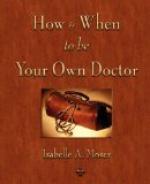Most non-life-threatening yet highly annoying disease conditions originate as secondary eliminations. For example, the skin was designed to sweat, elimination of fluids. Toxemia is often pushed out the sweat glands and is recognized as an unpleasant body odor. A healthy, non-toxic body smells sweet and pleasant (like a newborn baby’s body) even after exercise when it has been sweating heavily. Other skin-like organs such as the sinus tissues, were designed to secrete small amounts of mucus for lubrication. The lungs eliminate used air and the tissues are lubricated with mucus-like secretions too. These secretions are types of eliminations, but are not intended for the elimination of toxins. When toxins are discharged in mucus through tissues not designed to handle them, the tissues themselves become irritated, inflamed, weakened and thus much more subject to bacterial or viral infection. Despite this danger, not eliminating surplus toxins carries with it the greater penalty of serious disability or death. Because of this liability, the body, in its wisdom, initially chooses secondary elimination routes as far from vital tissues and organs as possible. Almost inevitably the skin or skin-like mucus membranes such as the sinuses, or lung tissues become the first line of defense.
Thus the average person’s disease history begins with colds, flu, sinusitis, bronchitis, chronic cough, asthma, rashes, acne, eczema, psoriasis. If these secondary eliminations are suppressed with drugs (either from the medical doctor or with over the counter remedies), if the eating or lifestyle habits that created the toxemia are not changed, or if the toxic load increases beyond the limits of this technique, the body then begins to store toxins in fat or muscle tissues or the joint cavities, overburdens the kidneys, creates cysts, fibroids, and benign tumors to store those toxins. If toxic overload continues over a longer time the body will eventually have to permit damages to vital tissues, and life-threatening conditions develop.
Hygienic doctors always stress that disease is remedial effort. Illness comes from the body’s best attempt to lighten its toxic load without immediately threatening its survival. The body always does the very best it can to remedy toxemia given its circumstances, and it should be commended for these efforts regardless of how uncomfortable they might be to the person inhabiting the body. Symptoms of secondary elimination are actually a positive thing because they are the body’s efforts to lessen a dangerously toxic condition. Secondary eliminations shouldn’t be treated immediately with a drug to suppress the process. If you squelch the bodies best and least-life-threatening method to eliminate toxins, the body will ultimately have to resort to another more dangerous though probably less immediately uncomfortable channel.
The conventional medical model does not view disease this way and sees the symptoms of secondary elimination as the disease itself. So the conventional doctor takes steps to halt the body’s remedial efforts, thus stopping the undesirable symptom and then, the symptom gone, proclaims the patient cured. Actually, the disease is the cure.




